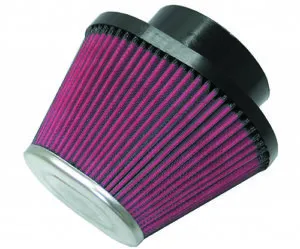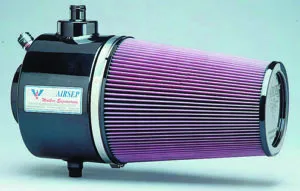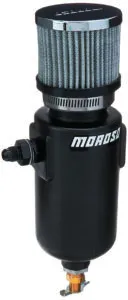Presumably, air cleaners are about dusty environments, and dust is a rare thing on the water. But is the engine room actually clean?
We’ve seen a lot of dust from V-belts and insulation. Salt mist settles on every surface. In PS oil filter testing (see “Marine Oil Filter Comparison”), we learned that a surprisingly high proportion of the solids in marine used oil seemed to consist of plant pollen and unidentified fibers. Diesel engines inhale about 1.5-2 cubic feet per minute per horsepower capacity. In the course of 100 engine hours, you can assume you’ve sucked all of the air out of 200 dirty garages.
An oily film covering the engine room is a common complaint. Oil leaks seem like the obvious cause, but a constant stream of crankcase ventilation gases is another source of oil. While running, there is a constant stream of combustion gases sneaking past the rings. While making its way through the crankcase, it collects water vapor and lube oil mist, which typically contains 1-2 grams per hour of oil and hydrocarbon. In the 1950s, gasoline engine manufacturers realized that water contamination and gasoline dilution of lube oil reduced engine life. To alleviate this they added crankcase ventilation valves (PCV valves), which enabled manifold vacuum to suck these gases out of the crankcase.
In 1964, the Environmental Protection Agency stepped in and mandated the practice because crank case emissions were a significant source of volatile compound pollution. Diesel fuel dilution of lubricating oil is less damaging than gasoline and air pollution is less. However, the EPA began phasing in closed ventilations systems for on-road diesels in 2004.
The crankcase vent on older engines was often terminated near the air intake, in the hope that most of the fumes would find their way into the engine. However, the vent was not connected to the intake for fear that a runaway condition was possible if a ring failed, with the engine using its own oil as fuel. This ends when the crankcase runs dry and the motor seizes, or when it over revs and breaks something important.
Most engines have some sort of cover and crude screening over the intake. This serves to deflect tools, parts, and broken fan belts, and to muffle the intake noise, which is often the greatest source of noise at lower RPM. Many manufacturers—Yanmar and Universal—forgo filters on marine engines, even although they are installed on industrial versions. A smaller number, mostly newer and larger models, have actual filters.
WHAT WE TESTED
We haven’t done the sort of detailed forensic examination of air cleaner elements that we did for oil and fuel filters. Those that have disposable elements typically change them very rarely, and most of those go straight into the trash, making them hard to collect.
As we learned, a portion of the foam filters were sucked right though the engines! Instead, we relied on interviews with service pros and sailors in the field.
Manufacturer Category Product Material Volume (Catch Can) Price
K&N * Filter Universal Fit Filter Fiber Not applicable $55.00
Unifilter Filter Universal Fit Filter Foam Not applicable $27.00
Moroso $ Catch can 85402 Polymer 950 ml, drain to engine optional $55.00
Vincos $ Catch can Universal 3/8”-9/16” Aluminum 400 ml, drain to engine; optional 750 ml available $28.00
Walker Manufacturing* Combined system Airsep Universal Polymer/metal/fiber Drains to engine $500.00
* Best Choice
$ Budget Buy
OBSERVATIONS
Always filter the air for a turbocharger. We’ve never seen a turbocharged engine that didn’t use an air cleaner, and we’ve seen firsthand what happens when solid particles, even small amounts of grit, get into the turbine. While not likely, you often need a new engine when it happens.

With terrestrial vehicles, oil analysis targets silica as an indicator of dusty conditions. It is abrasive and common in rock dust. But you wouldn’t expect to see that in a boat and we’ve never seen elevated silica in marine oil analysis. Instead, marine dust consists primarily of things generated in the engine room.
Belt dust is one source; just a little misalignment, and bits of rubber, including substantial chunks, have a chance of going through the engine. Oil and diesel fumes come out the crankcase breather. Some boats vent it out the back, some inside the engine room (messy) and some draft it into the engine, either via a fitting or simply by placing it near the intake. There is also plant matter, which goes farther than you would think. We’ve found a lot of pollen and fragments in used oil samples. Engine room insulation. Sea air and salt; if it gets in the cabin you can bet the engine breaths it in.

Foam filter elements have developed a reputation for disintegrating and getting sucked through the engine. Fitted to many engines as a rudimentary, flow-through filter (with little reduction in pressure), they are intended to be cleaned, oiled, and reused. However, the foam only lasts 6-8 years, after which it becomes weak and crumbly.
Of the sailors we interviewed with foam filters, about one third reluctantly admitted that they had let them go too long, and one day they just disappeared into the engine. Another third reported serious deterioration that they fortunately noticed in time. These were on Yanmar engines and generators by Northern Lights or Fisher/Panda. After this experience, each elected to remove the filter altogether or purchased a universal fit replacement from K&N Filters.
Although ingesting a foam filter appears to be relatively harmless to the engine, it is unsettling to say the least. If you have a foam element, replace it every three years, regardless of the hours or apparent condition.
Many engine makers offer an upgraded “industrial” version of their engines, and these are typically fitted with a disposable fiber element. Two sailors we interviewed had opted for these (one Caterpillar, one Yanmar) and were pleased. Replacement is recommended at 250 hours, or one year for industrial use, but we’re sure this could be extended to several years on a marine engine.
Several of the sailors we spoke commented on the filter’s effect on engine noise. Those who replaced silencers with filters found the engine to be somewhat louder at low rpms than with the factory silencer. The Walker Airsep claims to be significantly quieter than the stock silencer, and though we’ve not tested this feature, sailors who have upgraded to the Walker have confirmed this feature.

K&N Filters
The most common supplier of aftermarket intake filters for sailboats, they can spec a clamp-on filter and housing that will fit your old engine. These sturdy fiber filter elements won’t disintegrate like a foam filter.
Bottom line: Best Choice for someone looking for a quality fabric filter.
Unifilter
Unifilter makes filters for everything from lawnmowers to mansions and claims be “best air filters on earth.” The marine air filters we looked at were flexible-fit foam filters, and the owners we spoke with were pleased. However, these foam filters seem no more impervious to disintegration than OEM filters.
Bottom line: Unless you are scrupulous about maintenance, we recommend you avoid foam filters. Not recommended.
Catch Cans
The crankcase vent is a smelly mess. One solution is to run it to the transom, like the little smoking hoses you often see dangling below the bumper of a rear-engine bus. Still a mess. The risk in running the breather hose directly to the air intake is twofold. First, you may introduce water and lube oil, resulting in intake deposits. Not great for turbos either. Second, and more serious, if there is a malfunction of a piston ring, or if you overfill your oil, you risk a diesel engine runaway situation, where the engine runs on its own lube oil until it runs dry and seizes. (Another good reason to have and emergency stop button.)
One of the simplest ways to vent the crankcase of oil is to use a catch can. In this modification, the crankcase vent hose is led to a simple can. It can either be fitted with an air filter and allowed to exhaust into the engine room, or fitted with a hose and led back to the air intake. The accumulated oil can either be drained or led back to the crankcase. We’ve seen catch cans made from converted filter housings and assemblies built from pipe fittings, and they all worked. But there are some good inexpensive models on the market. Note that although these models come with air cleaners for discharge to the ambient air, that fitting can be plugged and the upper hose connected to the intake. Each manufacturer makes many models, depending on engine size. These are two we saw in service; check their catalogs and online retailers for what you need.
Moroso 85402
A bit larger than what you actually need, these filters from Connecticut-based Moroso will hold a quart of oil and water. One sailor who used this unit said he only collected a few ounces each season and would install something smaller next time.
Bottom line: We recommend a smaller size.

Vincos Universal
This simple can with a bracket is plenty for the typical sailboat engine or generator. One user drained it when he changed his oil, the other had led the drainage back to the crankcase.
Bottom line: Recommended.
Integrated systems
Integrated systems incorporate an air filter and a crankcase ventilation system. One of the most widely used in the marine industry is the Walker Airsep.
Walker Airsep
The first thing to address with the Walker system is the price. For about $500 (plus installation), the Walker system includes a coalescing crankcase vent filter that catches lube oil mist and returns it to the crankcase. The fumes are then sucked into the intake. Additionally, all of the fresh air is filtered. Is this really worth the money, when I can buy a simple catch can for $50 and an intake filter for $50? We could find no independent studies that definitively answered this. Our best guess is “maybe.”
In addition to separating the lube oil from the vent gases, the Airsep provides filtration of the vent stream and pressure regulation for the crankcase. A simple catch can system will continue to vent when a hot engine is shut down, but the Airsep has a pressure regulating valve system, something like the PVC valve on a car, that reduces venting after shut down, eliminating engine room odors. They are quite popular on the larger engines of motor yachts.
Bottom line: They probably have some benefit in terms of engine life, but just as importantly, they keep the engine room cleaner and the boat smelling fresher. For those who care not about price, this is our Best Choice.
CONCLUSIONS
The bottom line is that the engine rooms we’ve worked in and the outboard cowlings we’ve opened were seldom clean. Most of it is oil and soft stuff like pollen, lacking the sand and grit dirt roads kick up. But it can also be fiberglass insulation and bits of failed belts. You can skip the air filter if you like, just be certain to keep some guard or silencer in place to prevent inhaling large objects. Like the smaller outboard with no air or oil filter, most engines will die of something else long before inhaled dust becomes a factor. Only after corrosion, electrical gremlins, and fuel system problems are survived does bearing and cylinder wear become a factor.
On the other hand, if you obsess over oil changes, use OEM parts, and take every possible precaution to help your diesel reach extreme hours, then an air cleaner and catch can seem like obvious precautions. And perhaps even more important, by installing a system that sucks crankcase fumes back through the intake, all that good diesel smell will go out the tailpipe instead of into the cabin. Except for those who adore the fragrance of an engine room, that is a good thing.
Related post: Foam Filters Make Little Sense for Air Intake
This article was originally published on 31 January 2020 and has been updated.








































The Volvo Penta D2-55B engine silencer (air filter) is pretty cheaply made and very expensive to OEM replace. Being made of a center spring wrapped in foam (each sold separately) makes it a joke. After some frustration I settled on a K&N filter (RU-0810) that is much better made and cheaper. However, K&N doesn’t make it easy because that aftermarket replacement was determined only after measuring the engine air opening diameter and available space for the body of the filter, i.e. they don’t index their products for specific Volvo Penta engines and I found their search menu somewhat difficult to use.
~ ~ _/) ~ ~ MJH
I have a Valve D2-40 in my boat and changed from the original Volvo air filter to the KN model. Never looked back, perhaps a little more noise, but very little, I would highly recommend this to any Volvo small engine owner. Out of interest other mods have been changing to the Razor style fuel filter and recently a stainless exhaust elbow.
I have had a K&N filter on my 4-108 since 2007. No problems. I simply terminated the crankcase vent against the filter. Needs periodic cleaning.
When I remember, which is about 2/3 of the time, I pull the filter clear off when we lose sight of shore. Don’t know if it makes any difference or not; increases noise, but not a lot. Crankcase vent repositions to just over intake.
One of the most important functions of a marine engine air filter is as a flame arrester. Saw the result of an engine on an inboard with no filter. It backfired, set the boat on fire as it was motoring past the mooring in Weymouth UK harbour. The two people aboard jumped overboard and the flaming boat drifted alongside a sailboat, doing extensive damage. Boats are particularly vulnerable as propane, gasoline, oil etc accumulate in the bilges. A wire mesh is an effective arrester and a foam or paper filter should incorporate a flame arrester..
I gladly own a perkins turbo diesel 356 cu. Inch 6 cylinder. Perkins made the small CAT engines in the 70s and 80s.
I installed a CAT air filter purchased from a local equipment rental business. With some threaded rod and an end plate it’s on. Best think is the turbo whine is now muffled. With bilge ventilation I doubt air intake contamination is an issue. PCV are installed in engines to maintain vacuum in the crankcase. You don’t want cranks pressurized. That would blow oil seals and o rings.
Converted from a cast iron fitting, oil bath, air filter to a much simpler and lighter K & N. Bought a bent stainless tube, cut to fit, drew a pattern for the DIN gasket sized mounting flange and had a shop cut the flange and weld together. Fresh water boat, Farymann engine, so lots of the same parts probably used on shore in potentially dusty conditions, and we race so less weight easy to rationalize.
The breather oil recovery bowl is missing on the first photo – it still is somewhere under the engine. I’ve replaced it with another just like it. You really should publish photo credits…. Second time for me in this periodical.
I collect 1 per 100 engine hours so cleaning the catch bowl is done with an oil change. I’ve improved the engine slightly since this picture – which was taken for an article in the Catalina MainSheet, I’ve added a heim joint turnbuckle to tighten the belt, which has reduced the dust in the engine bay.
Btw – the remote oil filter shown has made changes much less messy
How would an “emergency stop button” be of any possible use in the event of engine runaway fueled by crankcase oil?
The only remedy in this situation is to have a mechanical (cable) air intake shutoff such as those found on GM two strokes of yore.
It might take a good deal of engineering in order to fit something like this on a tiny sailboat auxiliary’s intake silencer.
@Warren Agreed, to stop a runaway, you must remove air from the combustion as the fuel is out of reach. On small sailboat engines you do not need anything complicated. Blocking the air intake will work. Use a book or a board, just not your hand. It is good to know where the intake is and have a plan.
on my sailboat I rely on a VP MD2040.
Many yars back I came to realize that the VP foam filter is a piece of shit and (last but not least) a real rip-off.
So 10 years ago I disposed of the foam cylinder but I salvaged the inner metal spring and I wrapped around it a piece of the 2-layer (blue and white) cloth that is of common use for air conditioners. Cheaper than fools. I think I paid less than 4 Euro for a couple of square meters and I have yet a large piece for spare. I change the cloth every year (as I said wrap it around hte spring with the light blue layer on the outside, clamp it on the collar of the exhaust and trim the excess with a scissor).
Cheap, effective and reliable.
I have two Penninsular 6.5 lt Diesel engines on my boat (turbo charge). Penninsular was acquired by Unique Marine about two years ago and now they announced that they are negotiating their parts department and they won’t be able to dispatch parts until then. I need to get the air filters for my turbos (the ones I have are the foam covered). Cons you recommend a good replacement?